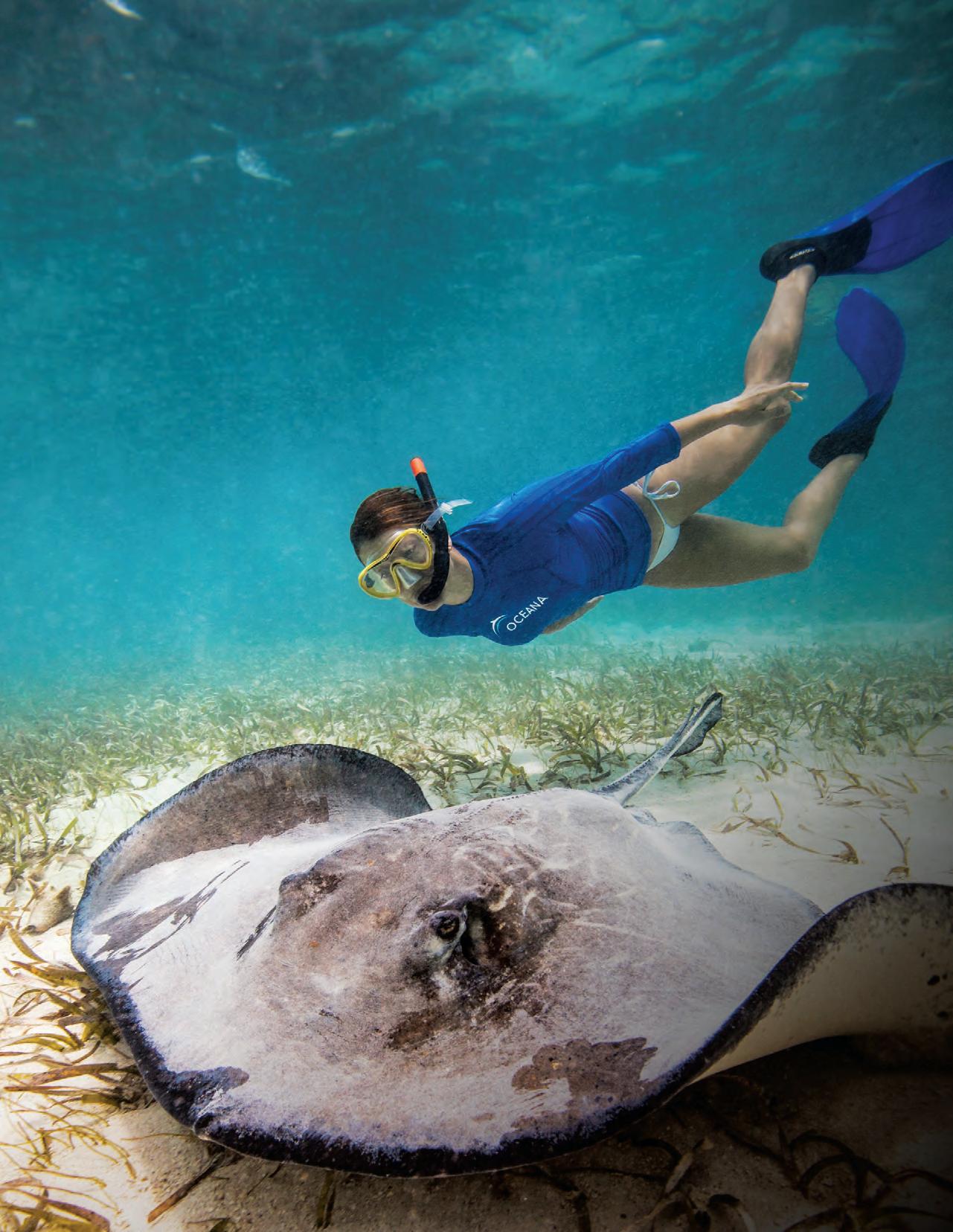
PLUS GREAT WHITE SHARKS IN JEOPARDY ANCHOVY’S COMEBACK VICTORIES IN CHILE AND SPAIN Kate Walsh campaigns against offshore drilling in Belize A REEF AT RISK FALL/WINTER 2012 | oceana.org
Oceana is the largest international advocacy group working solely to protect the world’s oceans. Oceana wins policy victories for the oceans using science-based campaigns. Since 2001, we have protected over 1.2 million square miles of ocean and innumerable sea turtles, sharks, dolphins and other sea creatures. More than 500,000 members and e-activists support Oceana. Global in scope, Oceana has offices in North, South and Central America and Europe. To learn more, please visit www.oceana.org
board of directorS
Dr. Kristian Parker, Chair
James Sandler, Vice Chair
Simon Sidamon-Eristoff, Secretary
Valarie Van Cleave, Treasurer
Keith Addis, President
Herbert M. Bedolfe III
Ted Danson
Sydney Davis
César Gaviria
María Eugenia Girón
Stephen P. McAllister
Michael Northrop
Dr. Daniel Pauly
Susan Rockefeller
Heather Stevens Roger van Vliet
Sam Waterston
oceana
Chief Executive Officer
Andrew Sharpless
Executive Vice President & General Counsel
James Simon
Senior Vice President, North American Oceans & Chief Scientist
Michael Hirshfield, Ph.D.
Vice President, European Oceans and Seas
Xavier Pastor
Vice President, South American Oceans & Antarctica
Alex Muñoz
Vice President, Belize
Audrey Matura-Shepherd
Vice President, Strategic Marketing & Communications
Matthew Littlejohn
Vice President, Global Development
Bettina Alonso
Deputy Vice President, U.S. Campaigns
Jackie Savitz
Deputy Vice President, Pacific Susan Murray
ocean coUncil
Susan Rockefeller, Chair
Julie Tauber McMahon, Vice Chair
Dr. Andrew Bevacqua
Carolyn Marks Blackwood
Keely and Pierce Brosnan
Deborah Buck
Barbara and Bertram Cohn
Ann Colley
Dan and Beth Cort
Andrew and Sydney Davis
Michael Dershowitz
Brenda Earl
Barbara Ettinger and Sven Huseby
Christina Falco and Michael Frumkin
Joanna and Brian Fisher
Kelsey Grammer
Lea Haratani
Julie Hill
Carey Hotchkis Hardy Jones
J. Stephen and Angela Kilcullen
Robert and Arlene Kogod
Slane Holland Lightburne
Cynthia Lufkin
Willa and Ted Lutz
Dede McMahon
Tiffany Moller
Vanessa Noel
Aaron Peirsol
Nicole Polizois
Lois Robbins
Anne Alexander Rowley
Eve Kornyei Ruffatto
Andrew Sabin Starr Scott
Jennifer Small and Adam Wolfensohn
Kelly T. Smith
Danielle Steakley
Sutton Stracke
Danielle Thomas Susan Trees
editorial Staff
Editorial Manager
Emily Fisher
Assist ant Editor
Pete Brannen Graphic Designer
Jenn Hueting
FALL/WINTER 2012 CONTENTS
6 Jaws in Jeopardy
Oceana is campaigning to protect a vulnerable population of great white sharks off the U.S. West Coast.

Oceana is published by Oceana Inc. For questions or comments about Oceana, or to subscribe to Oceana, please call Oceana’s membership department at +1.202.833.3900, e-mail membership@oceana.org or write Oceana, Member Services, 1350 Connecticut Ave. NW, 5th Floor, Washington, D.C. 20036, USA.
Oceana’s Privacy Policy Your right to privacy is important to Oceana, and we are committed to maintaining your trust. Personal information (such as name, address, phone number, e-mail) includes data that you may have provided to us when making a donation or taking action as a Wavemaker on behalf of the oceans. This personal information is stored in a secure location. For our full privacy policy, please visit Oceana.org/privacypolicy.
Please recycle.
Printed with Eco-Ink — low volatility vegetable oil-based ink on 25% post-consumer recycled, processed chlorine free paper produced using 100% wind power in a carbon neutral process.
6
White sharks are in peril off the US west coast.
© David P. Stephens
return The remarkable collapse and recovery of anchovies in the Bay of Biscay.

profile: alaska pollock A friendly introduction to one of the world’s most popular seafood species.
Oceana board member Dr. Daniel Pauly answers the question: What are forage fish and why do they matter?
On the Cover

Actress Kate Walsh swims with a ray in Belize.
parting Shot Kate Walsh snorkels in Belize.
Do you know what’s in your Filet-O-Fish sandwich?
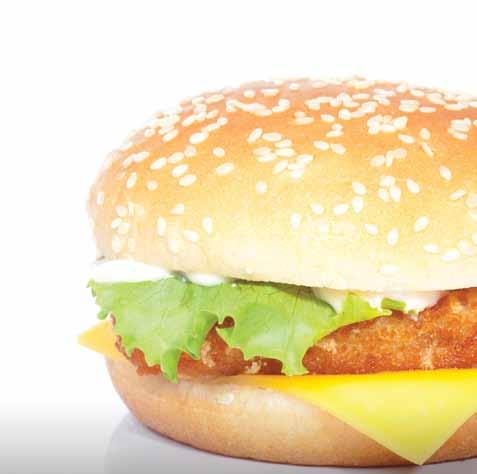
f eat
d e
U r e S
partment S 9 anchovy’s
11
13 What are forage fish?
OCEANA.ORG 1
2
4
5
14
17
18
19
ceo’s note A new report offers bad news and good news for the world’s fisheries.
making Waves The latest campaign victories from Oceana’s international team.
news & notes The 2012 Ocean Heroes, Kate Walsh visits Belize and more.
Q & a Author Callum Roberts discusses his new book, “The Ocean of Life.”
events SeaChange Summer Party, GQ Gentlemen’s Ball and more.
Supporter Spotlight Tricia and Michael Berns on their commitment to ocean conservation.
chef’s corner British chef Hugh Fearnley-Whittingstall with a recipe for quick-fried mackerel.
11
How
9
© Tony Rath
Spain’s anchovy stock came back
Give Today
Call us today at 1.877.7.OCEANA, visit www.oceana.org/give or use the envelope provided in this magazine to make a donation. Please contact us if you are interested in planned giving that could support Oceana’s work and also provide you with income and potential tax benefits. Oceana is a 501(c)(3) organization and contributions are tax deductible.
 Protecting the World’s Oc eans
Protecting the World’s Oc eans
Oceana’s accomplishments wouldn’t be possible without the support of its members. You can help Oceana campaign to restore our oceans with your financial contribution.
The Association for the Advancement of Science, known as the “triple A-S” among the scientific cognoscenti, tracks, as its name suggests, the advancing frontier of knowledge. The most important discoveries are culled for publication in its journal, Science
The current issue is on my desk beside me today, and it includes an important and sobering report. It used cutting edge statistical analysis to look at fisheries with limited data, mostly those in the developing world. And it found that fisheries in the developing world are largely in terrible shape.
The good news is that, as this report confirms, fisheries that put in place sensible management measures do come back and become abundant once again. This is important because these declining fisheries are an essential source of food to hundreds of millions of people.
Stopping the collapse of these fisheries is what motivates us here at Oceana. We do that by winning and enforcing national policies that require scientifically sound fishing quotas, protect nursery habitat, and
reduce bycatch (the accidental killing of non-target species). This issue of Oceana brings you more news of our progress on all fronts.
Managing ocean fisheries better so they can feed more people is the most achievable global conservation opportunity of our time. It’s also a food security opportunity vital to the 1 billion people already suffering from hunger and malnutrition. And with human population on track to reach 9 billion by 2050, this food resource is essential to all of us.
Well-managed oceans can feed 700 million people a healthy seafood meal every day in the year 2050.
And they can do so cost-effectively. Marine fish are, on a per pound basis, the most cost-effective animal protein on the planet. Compare them to pork, cattle, poultry –you name it – and wild ocean fish are, on average, the most affordable animal protein.
In addition, a healthy ocean reduces the cutting of forests and lessens demands for fresh water.
That’s because terrestrial livestock is fed vast amounts of grain, and those grain fields need irrigation. A hungry world demands animal protein, and if the oceans collapse, livestock production will increase even faster. Livestock production equal to the wild fisheries of a well-managed ocean would require 200 million acres of grain fields – an area equal to half of all the cultivated land in the United States, or an area greater than Turkey, or an area nearly three times the US area currently planted in corn. New farm fields will inevitably require more cutting of forests.
So if you’re contributing to Oceana, you’re not only helping to save the world’s oceans and to feed hundreds of millions of hungry people. You’re also helping to save the world’s forests.
Thank you!
Andy Sharpless CEO
Oceana is grateful for the grants, contributions, and support it has received from dozens of foundations and companies and thousands of individuals. Oceana wishes to thank all of its supporters, especially its founding funders as well as foundations and individuals that in 2011 awarded Oceana grants totaling at least $500,000: Adessium Foundation, Arcadia Fund, Gordon and Betty Moore Foundation, Oak Foundation, Oceans 5, Planet Heritage Foundation, Robertson Foundation, Rockefeller Brothers Fund and the Sandler Foundation of the Jewish Community Endowment Fund.

OCEANA.ORG | 1 titleceo’S note
1979 1989 1999
0.6 0.7 0.8 0.9 1.0 1.1 1.2 Level of fishing exploitation Year Well-studied fisheries (mostly U.S. and Europe) Fisheries in the developing world Responsible fishing level Average global fish stock trend
2009
New evidence that we can and must bring our fisheries back from the brink.
Derived from “Status and Solutions for the World’s Unassessed Fisheres, Costello et al, Science, 27 September, 2012.
Leatherback sea turtle becomes California state symbol

Oceana
a
Spain’s Doñana National Park saved from oil drilling
The Spanish government put an end to a proposed oil industry development that would have threatened Doñana National Park, a UNESCO World Heritage Site.
Plans to build an oil refinery in the Gulf of Cádiz, not far from Doñana, would have led to higher ship traffic in the area and a higher risk of oil spills or accidents during the tankers’ unloading operations, threatening animals such as the avocet and purple heron. Oceana is currently working to create a Marine Protected Area in this section of the Gulf of Cádiz, which would be linked to the National Park. Oceana identified the threats posed by the construction of this oil refinery in 2005, and has been campaigning against it with other groups.
‘Freezing the menu’ for forage fish
After campaigning by Oceana, the Pacific Fishery Management Council finalized its decision to prohibit the development of new fisheries for currently unmanaged forage fish off the West Coast.

Forage fish are the ocean’s small fish and invertebrates, such as lanternfish, smelts, saury and small squids, which serve as prey for larger animals, including dolphins, whales, seabirds, and fish species like salmon, tuna and rockfish. They have immense ecological and economic value, but can only serve their role as prey when they are left in the water.
The decision to “freeze the menu” builds on Oceana’s previous success to prohibit a fishery on krill, and sets up a process and timetable for interim protective measures and a regulatory process to implement a long-term prohibition on new fisheries.
2 | FALL/WINTER 2012 title
The California legislature and Governor Brown designated the endangered Pacific leatherback sea turtle as California’s official state marine reptile and declared October 15 as the state’s annual Leatherback Conservation Day.
was
key champion of the bill and won statewide support from thousands of California citizens and more than 30 conservation entities including the California Fish and Game Commission. This new symbol of the Golden State recognizes the importance of California waters to the survival and recovery of this endangered and ancient sea turtle species and encourages further conservation efforts.
makin G Wave S © OCEANA | Eduardo Sorensen
© Tim Calver
Victories for sharks in Europe
For the first time in its 60-year history, the General Fisheries Commission for the Mediterranean took action for shark protection. The Commission adopted measures for the management and conservation of sharks and rays in the Mediterranean. Twenty-three Mediterranean countries endorsed a proposal from the European Union that bans the unsustainable practice of shark finning, prohibits trawling in some sensitive near-shore habitats, and requires countries to collect and report data on catches of some threatened species.
protecting 10 threatened species of sharks and rays in the Mediterranean Sea. These species, including hammerheads, tope, and shortfin mako, have declined dramatically in numbers – some by as much as 99 percent during the last century –while others have vanished from parts of the Mediterranean where they were once common. Oceana was the only NGO pushing for this measure.
Finally, the Fisheries Committee of the European Parliament voted to support a strict ban on shark finning both in European Union waters and on EU ships worldwide. The new policy, which must be approved by the rest of Parliament, would close loopholes in the EU’s existing shark finning policy, which allowed some vessels to remove fins at sea.
Coal-fired power plant defeated in northern Chile
A planned coal-fired thermoelectric power plant known as Castilla in northern Chile was rejected by the Chilean Supreme Court, a victory for Oceana and its allies.
Coal-powered thermoelectric power plants are notoriously dangerous to the environment. This plant was planned for the Punta Cachos area off of Chile’s northern coast, just a few miles from important habitats for Humboldt penguins and sea turtles. As part of its operations, the plant would have released warm water into the ocean, which would have negatively affected the entire ecosystem.
illinois bans shark fin trade
Illinois became the first inland state to ban the trade of shark fins, following similar bans passed by California, Oregon, Washington and Hawaii in the growing national movement to protect sharks.
Although Illinois is far from the ocean, it imports large amounts of shark fins that are used in the Asian delicacy, shark fin soup. This market demand for fins creates an incentive for the continued practice

of shark finning, where a shark’s fins are sliced off at sea and the body is thrown overboard while the shark is often still alive. Tens of millions of sharks are killed each year for their fins, contributing to population declines as large as 99 percent in recent decades.
While shark finning is illegal in the United States, there are few federal laws that address the trade of shark fins. In fact, many shark fins are imported into the U.S. from countries with few or even no shark protections in place.
Despite initial approval by the local environmental commission, the plant was opposed by the local community and various other organizations, including Oceana. The community fought against the plant and won, getting its approval revoked, but the company appealed, bringing the case to the Supreme Court, which finally ruled against the plant. Oceana continues to campaign in Chile against plants like Castilla, which generate pollution that threatens coastal ecosystems, the safety of the local air and water, as well as the health of local communities.
OCEANA.ORG | 3 title
In another win for European sharks, the EU also voted in favor of strictly
makin G Wave S
© OCEANA | LX
Thousands voted to crown Oceana’s 2012 ocean heroes. This was the fourth consecutive year Oceana has held its celebration of everyday individuals making a difference for the oceans. The 2012 Adult Ocean Hero is captain don voss, the owner of the Marine Cleanup Initiative Inc., an organization that cleans up Florida’s waterways. Over the last 11 years, the company has removed over 300,000 pounds of marine debris. The 2012 Junior Ocean Hero is 15-year-old James hemphill, the president of Project Green Teens, a student-run environmental group that promotes conservation in Virginia Beach. The group has removed more than a ton of trash from Virginia waterways. The prizes for this year’s Ocean Heroes were generously provided by Nautica and Revo Sunglasses.
Oceana CEO Andy Sharpless is writing a book, forthcoming from Rodale next spring. The book, tentatively titled “the perfect protein: a fish-lover’s guide to saving the oceans and feeding the world,” reveals a major, overlooked answer to growing global food demand: wild seafood.
On World Oceans Day, June 8, Actress and Oceana supporter Kate Walsh (“Private Practice”) traveled to Belize to advocate for Oceana’s campaign to prevent offshore drilling in the Central American nation. She snorkeled in some of the country’s most beloved marine places that are threatened by proposed drilling, such as Lighthouse Reef Atoll, the Blue Hole and the Hol Chan Marine Reserve.

In August, Oceana was again a conservation partner of discovery’s Shark Week. The 25th anniversary of Shark Week featured several conservation-oriented programs, including a show titled “Great White Highway” narrated by Oceana board member Ted Danson.

Oceana released a new report, “Ocean-Based Food Security Threatened in a High CO2 World,” which ranks nations that are most vulnerable to reductions in seafood production as a result of climate change and ocean acidification. While seafood is currently a primary source of protein for more than a billion of the poorest people in the world, carbon dioxide emissions are causing the oceans to warm and become more acidic, threatening fisheries and the people who depend on them. Rising ocean temperatures are pushing many fish species into deeper and colder waters towards the poles and away from the tropics, while increased acidity is threatening important habitats such as coral reefs and the future of shellfish like oysters, clams and mussels.
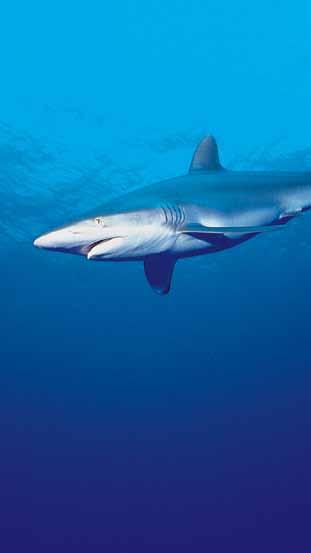
title
1
neWS & note S 4 | FALL/WINTER 2012 54 3
callU m
r
is a professor of marine conservation at the University of York in England and author of the 2007 book “The Unnatural History of the Sea.” His second book, “The Ocean of Life,” was published this spring. Oceana asked Roberts about the new book and
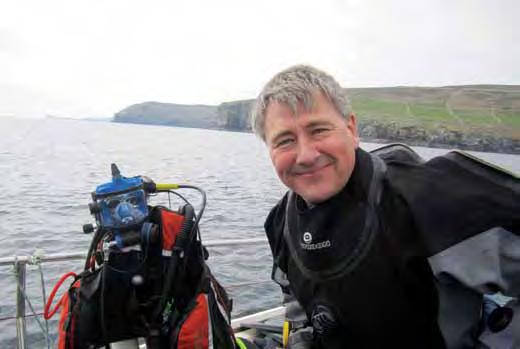
a “New Deal” for the oceans.
how does “the ocean of life” differ from your first book, “the Unnatural history of the Sea?”
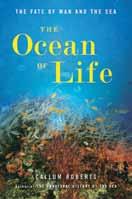
“The Unnatural History of the Sea” is about how 1,000 years of hunting and fishing have changed the oceans. It is a voyage through time and around the world in which I let eye witnesses tell their stories of discovery, plunder, glory and heartbreak, and in doing so let us see the oceans in a new light, as if for the first time. “The Ocean of Life” is painted on a bigger canvas. In it I go back to the very beginning in an effort to answer questions like, where did the oceans come from, what were they like before the Cambrian explosion of larger life, who were the first seafood lovers and where did they live? Although I cover the long history of fishing, it is by way of prelude to an exploration of the many other ways in which we are changing the oceans. Almost without noticing it and within my lifetime, humanity has gained dominion over the sea.
What’s the most surprising thing you learned about the oceans while researching and writing “the ocean of life?”
Probably the most startling and troubling thing I learned, when I drew together the many intertwining strands of our influence, is that the oceans are changing faster today
and in more ways than in all of human history. In fact, we may have to go all the way back to the planetary cataclysm that ended the reign of the dinosaurs 65 million years ago to find a more rapid transformation of the sea.
considering all the threats facing the oceans that you outline in the book, which do you think most urgently needs to be addressed?
Of course, we are the root cause of all the problems the oceans face and it is ourselves we must change. The astonishing increase in global population coupled with our ingenuity in devising ever more elaborate ways to live in material comfort make it inevitable that we will continue to exert a huge influence on the planet. So we have to find ways to live within our means and transition to renewable energy. Assuming we do this to save ourselves, conditions will get better eventually for life in the sea; the problem is, they are going to get worse first.
So what can we do to help life through the hard times ahead? That is where I think we need a “New Deal” for the oceans which would jointly target overfishing and pollution to rebuild life in the sea.
can you summarize this “new deal” for oceana readers?
Throughout vast swathes of the seas we have brought life to its knees. We have reduced once rich and vibrant ecosystems that thronged with giant fish and mammals to places where not much at all lives now.
Marine life, as Charles Dickens might have put it, is suffering reduced circumstances. So the centerpiece of this “New Deal” is to increase the abundance of life once again, to bring back the megafauna and to recover complex biogenic habitats. In a nutshell, to do this we need to fish less using less destructive, more selective methods, waste less, pollute less and protect more. That protection would mean expanding the global network of no-take marine reserves to about 30 percent of the oceans.
What do you hope readers take away from your book? Who do you hope is reading it?
That what is happening to the sea demands our urgent and undivided attention. Because the oceans make up over 95 percent of the volume of the biosphere they are overwhelmingly important to keeping our planet habitable. We ignore this fact at our peril. Since we all have a part to play in looking after the world, I hope the book finds readers from high school students all the way up to politicians, philanthropists and captains of industry. I wrote it for everyone.
OCEANA.ORG | 5
the oceans are changing faster today and in more ways than in all of human history.
Q & a
ob ertS
why we need
by r achael p rokop
imagine for a moment if the movie “Jaws” were re-made, but instead of playing the man-eating villains, sharks were the victims. massive fishing nets would entangle and drown young sharks, while humans frolicked, carefree, on the beach.

That movie could be made now, but it would be a documentary. Off the West Coast of the United States and Baja California, Mexico, the famed small population of great white sharks is facing the specter of extinction, and Oceana is fighting to save them.
The villain in our story is the gillnet, a “curtain of death” hundreds of yards long that poses the single greatest threat to the future of these sharks. Gillnets are indiscriminate— they catch the fish they are intended for, and anything else swimming by. The region’s main gillnet fisheries are off southern California, waters that also happen to be a nursery for great whites.
The peak seasons for California halibut, white seabass, and swordfish, all targeted by gillnets, coincide with the season that young great white sharks congregate in these waters. Every year, on average over 10 great white shark pups are reported to be accidentally caught in these nets, and more, scientists believe, are unreported.
That may not sound like a large number, but recent studies estimate there are only a few hundred adult great white sharks left in the West Coast population, which is genetically distinct and geographically isolated from other white shark populations worldwide.
Like humans, great white sharks mature slowly and have long pregnancies. A female great white pup will not be ready to breed until she’s about 12-14 years old, and once she does, she’ll only be able to give birth every other year at best. With such a slow reproductive rate, it’s hard for the population to replace pups lost to gillnets. And each pup that doesn’t make it to adulthood means there will be one less shark in the next generation’s mating pool.
A smAll populAtion of greAt white shArks is fAcing the specter of extinction, And oceAnA is fighting to sAve them.
 © Jim Agronick
© Jim Agronick
Despite their dangerously low numbers, these animals are not currently protected under the Endangered Species Act. They should be. Such a listing could change their future and help propel them out of the path to extinction.
Along with the Center for Biological Diversity and Shark Stewards, Oceana petitioned both the federal government and the state of California to have the West Coast great white shark population protected as an endangered species.
As a geographically isolated, geneticallydistinct population whose numbers are so alarmingly low, these sharks fit the criteria of an endangered species.
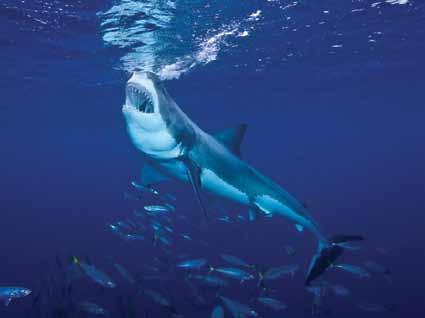
In response to the petition, the National Marine Fisheries Service (NMFS) determined that the population merits further consideration for listing as an “endangered” or “threatened” species. Over the next nine months, NMFS will conduct an in-depth status analysis of the population and determine whether to add this population to the federal endangered list.
If these great whites are added to the Endangered Species List, they would be granted greater protections from gillnets and other human threats. These protections could include transitioning these fisheries to more responsible fishing methods, increasing observer coverage to ensure that we know how many sharks are being caught, setting hard limits on the amount of white sharks that can be caught as bycatch, or creating protected areas for the sharks.

“Great white sharks off the U.S. West Coast are in a perilous situation,” said Susan Murray, Oceana’s senior director
for the Pacific. “An endangered species listing of these powerful apex predators will provide a protective safety net, giving us more time to better understand the status of this unique population.”
Great white sharks play an important role in ocean health. As top predators, great whites keep the ocean food web in balance, just as wolves and mountain lions keep deer populations in check. By hunting predatory marine mammals like seals and sea lions, sharks help keep fish populations healthy, which provide food for many species, including humans.
A lot is unknown about great whites— from their mating habits to the reasons behind their long migration patterns. Official recognition as an endangered species would bring more funding towards conservation research, giving us the tools to learn more and, in turn, better protect them before it is too late.
Without increased protections, the West Coast’s great white sharks could disappear forever, a fate that we simply can’t allow.
8 | FALL/WINTER 2012
As top predAtors, greAt whites keep the oceAn food web in bAlAnce, just As wolves And mountAin lions keep deer populAtions in check.
© Jim Agronick
BY P ETE R B RAN NEN
during the Roman Empire, sauces conjured from the humble anchovy dressed the plates of emperors. On Spanish street corners, whether served fresh, boqueron, or as salted anchoas , the anchovy has been a stable of Iberian cuisine for centuries.
Then, a decade ago, after years of irresponsible fishing, the anchovy stock collapsed in Spain’s Bay of Biscay.
The crash was the perfect storm: a fishery that naturally suffers wide swings in population numbers from year to year and a fishing fleet that was determined to exploit it according to its own numbers.
Anchovies are a short-lived species, typically living three to four years, while most of the fish that are caught are only one year old. The health of the stock in any given year, therefore, is heavily dependent on the spawning success
of the previous year, which in turn is affected by a number of environmental and oceanographic factors. This is a species that needs to be especially well-monitored and managed to ensure that a bad spawning season is not compounded by unsustainable catch levels from the fleet of Spanish and French purse seiners and trawlers that pull giant shoals of the schooling fish out of the Atlantic by the millions.
That’s exactly what happened nearly a decade ago, says Oceana Europe marine scientist Javier Lopez.
“The total allowable catch (TAC) of the anchovy was set independently of the state of the stock, so scientific advice was ignored and only the opinion of the fishing sector was predominant,” he said. “Normally this kind of short-lived species suffers some variation so for several years maybe the TAC was right but for many others the TAC was wrong. It was really, really wrong.”
I n the early 2000s, after years in decline, the anchovy stock in the Bay of Biscay plummeted. From the stock’s previous high catch of almost 90,000 tons, the catch dropped to just under 10,000 tons in 2003. Thanks to pressure from Oceana, the European Union closed the fishery in the Bay of Biscay for four years starting in 2005— and the anchovies slowly returned.
When the population exploded in 2009 the fishery was reopened. But
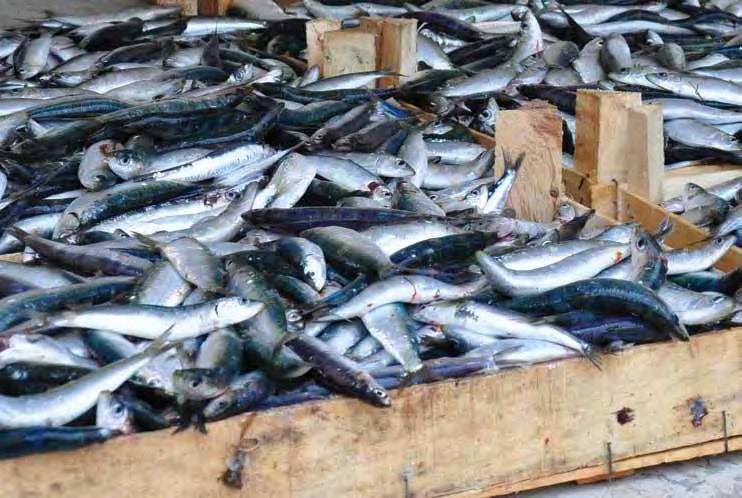
OCEANA.ORG | 9
In the early 2000s, after years in decline, the anchovy stock in the Bay of Biscay plummeted.
Anchovies and sardines are unloaded from a purse seiner in the port of Ayvalik, Turkey.
Anchovy biomass evolution in Bay of Biscay
CLOS URES 2005 - 2009
Anchovy biomass Overfishing threshold
even after four years of closure, catch levels were once again set above the scientific recommendations for the species thanks to pressure from the fishing industry.
“It made no sense,” said Lopez.
In the years since, however, the EU has taken the lessons of the last decade to heart. After a 2011 season that saw the highest abundance in anchovy stock since studies of the population began in 1987, the governing body of the EU lauded the new scientific approach.
“This is a good example that sustainable fisheries management, based on a long-term approach and with involvement of the industry pays off,” the European Commission said.
Over the past two years the total allowable catch limit of anchovies in the Bay of Biscay has been in line with scientific recommendations for
the first time in nearly two decades of management.
“The EU is acting responsibly,” said Lopez. “They’ve realized that they have to do it this way if they don’t want the fisheries to be depleted. We are really blessed with this new situation.”
But Oceana isn’t finished. As the EU puts together a management plan for the fish going forward, Oceana is pushing to have sensible measures put in place to prevent another disaster. One obvious solution would be to have catch limits tied to the total percentage of anchovy biomass in a given year, rather than set at a predetermined and arbitrary figure.
“That makes sense,” said Lopez. “If you have more biomass you can catch more fish. It’s logical.”
Oceana is also fighting against a proposal to set a minimum yearly
catch limit of 7,000 tons, regardless of the health of the stock, as well as a proposal to limit the amount that the catch could be reduced from year to year, again, regardless of scientific recommendations.
As food lovers know, anchovies are an umami powerhouse, conveyor of that elusive fifth taste, giving Worcestershire sauce and Caesar salad dressing their tang and immeasurably enriching any puttanesca sauce. For the Spanish the anchovy is a national treasure. Whether it remains to be so well into the future depends largely on the cooperation of governments, fishermen, scientists and groups like Oceana.
“Oceana has been practically the one and only NGO pushing for the recovery of the anchovy,” said Lopez.
10 | FALL/WINTER 2012
2000 20 40 60 80 100 120 2002 2004 2006 2008 2010 2012
Spawning stock biomass x1000t Year FISHERY
BY E MILY F I SHER
When you consider that Alaska pollock is one of the most widely consumed seafood species in the United States and the world, it’s surprising how little the average person knows about this cousin of cod. We thought an official introduction was in order.
Think fast: What is the fish you are most likely to meet in your McDonald’s FiletO-Fish sandwich?


Tilapia? Wrong.
If you answered Alaska pollock, nice work.
The fish in frozen fish sticks or breaded fish in your kid’s school lunches? Probably Alaska pollock, too. And that mysterious fake crab stick you had in last night’s sushi? It’s surimi, a fish paste made from Alaska pollock, which is also molded into imitation crab, lobster and shrimp.
Pollock is everywhere.
And humans aren’t the only ones that enjoy the ubiquitous whitefish. Just about everything that lives in the Bering Sea eats pollock, including humpback whales, beluga whales, puffins, Steller sea lions, Northern fur seals, salmon, halibut and some of the largest colonies of nesting seabirds on earth.
The walleye pollock is a medium-sized member of the cod family and gets its name from the white circles around its eyes. Pollock travel in enormous schools. The juveniles feast on the cold northern Pacific’s copepods and krill, which are tiny crustaceans.
The fish is fecund, producing up to two million eggs each over a couple weeks’ spawning period.

“Without pollock, the Bering Sea ecosystem would look a lot different. Pollock are a central component of the food web,” said Oceana scientist Jon Warrenchuk, who has been keeping an eye on the pollock fishery from Oceana’s Juneau, Alaska office for years. Oceana is working to ensure that the fishery leaves enough pollock in the water for both humans and the many animals that rely on it.
In addition to playing a central role in the Bering Sea food web, pollock is the target of the biggest fishery in the United States and one of the biggest in the world. The fishery is worth over a billion dollars today, but prior to the invention of the fish stick it was virtually unknown as a food fish. Russian and Japanese trawlers plied the Bering Sea until 1976, when the Magnuson-Stevens Act required that American companies alone harvest marine resources within 200 nautical miles of the coast. What began as a small fleet in the 1960s has exploded into a major industry in Alaska that catches more than 1 to 2 billion pollock a year.
Unfortunately, several stocks of pollock in Alaska were fished too heavily in the past, leaving too few fish behind to replenish those populations. In some cases the stocks have made no signs of recovery. Most of the world’s pollock supply now comes from the remaining pollock stock in the Eastern Bering Sea, which is currently at about 30 percent of unfished levels.
While the pollock fishery is relatively clean compared to some other U.S. fisheries, because of the massive volume of pollock fishing, large quantities of other fish and marine life end up in the nets.
For example, the pollock fleet has caught more than its share of the rare and valuable Chinook salmon as bycatch. The fishery caught more than 120,000 Chinook salmon in 2007. After campaigning by Oceana’s staff and allies, in 2008 the
North Pacific Fishery Management Council set a hard cap on Chinook bycatch at 60,000 salmon per year in the Bering Sea. That means if the pollock fishery surpasses that number, it will be shut down.
The pollock fishery has a reputation as one of the best-managed fisheries in the world, thanks to Alaska’s extensive infrastructure for data collection, scientific assessment, in-season monitoring and enforcement. All this data means that the system can quickly respond to changes in the water. For example, in 2010, in the face of severely declining pollock numbers, the pollock catch limit was set at its lowest level in 32 years. Since then, the stock has increased somewhat, but is still nearly 70 percent below historic levels and well below its long-term average.
Of the three basic principles of fishery management – set scientifically-based catch limits, reduce bycatch and protect habitat – the pollock fishery is doing some things right, but there is clearly room for improvement. The fleet uses mid-water trawling gear that’s supposed to avoid making contact with the seafloor, but the nets hit the bottom an estimated 44 percent of the time, which can damage seafloor habitats. There are some measures in place to reduce impacts on marine mammals, but Steller sea lions and Northern fur seals, which rely heavily on pollock, are still endangered or declining.
So, with all of this in mind, how should seafood consumers feel about eating pollock?
Assessing the sustainability of such a large and complex fishery is no simple undertaking. The Monterey Bay Aquarium’s Seafood Watch program has ranked Alaska pollock as a “Good Alternative”, its moderate “yellow” ranking – it’s not yet overfished, but there is significant room for improvement. Oceana will continue to work with government agencies, local communities, and fishermen to ensure that this fish, which is so important for feeding people and supporting a healthy Bering Sea ocean ecosystem, is managed for a sustainable future.
Alaska Pollock
nickname S
alaska pollock, walleye pollock, Theragra chalcogramma
p rod U ct S
m c d onald’s filet- o fish, frozen fish sticks, surimi, imitation crab
h onor S
b y weight, nation’s largest fishery and world’s second largest
b i rthplace
the majority of the U.S. catch of pollock comes from the b ering Sea, though a small portion is also caught in the Gulf of alaska.
W ei G h t
from 1977-2011 the catch of eastern b ering Sea pollock averaged 1.17 million tons.
n e t Wo rth
the alaska pollock fishery is one of the most valuable in the world. the 2010 pollock catch from the b ering Sea was valued at more than $282 million and products made from pollock were valued at $1 billion.
f i S hin G m ethod
trawlers tow large cone-shaped nets the size of a football field for miles to catch schools of pollock.
What are forage fish?
To explain the importance of forage fish, first we must go back to the basics of who eats whom, on land versus in the ocean. On land it is very easy. We either eat plants, or animals that have eaten plants, or a mixture of the two.
Re-expressed in term of trophic levels, i.e., steps in the food chain, this means that we have trophic level 1, which are plants. Then we have trophic level 2, things that eat plants, and level 3, animals that eat planteating animals (e.g., cows, eating grass). So, for example, if you have a diet of 90 percent vegetable matter (fries, salads, the onions on hamburgers), plus 10 percent meat, you have a trophic level of 2.1.

In the sea, the equivalent of grass and corn and other edible plant matter are microscopic algae known as phytoplankton. The plant-eating marine herbivores, the equivalent of deer and cows on land, are tiny zooplankton, usually less than one-tenth of an inch, and we don’t eat them. They are eaten instead by small schooling fishes such as sardines, herring, and anchovies. We call these forage fish because they serve as food for larger
¹ Pikitch, E., P.D. Boersma, I.L. Boyd, D.O. Conover, P. Cury, T. Essington, S.S. Heppell, E.D. Houde, M. Mangel, D. Pauly, É. Plagányi, K. Sainsbury and R.S. Steneck. 2012. Little Fish, Big Impact: Managing a Crucial Link in Ocean Food Webs. Lenfest Ocean Program, Washington, DC. 108 p.
animals in the ecosystem, for example, cod and tuna among fishes, sea lions and humpback whales among marine mammals, and sea birds such as pelicans and gannets.
Since forage fish have trophic levels usually around 3 (because they mainly consume herbivorous zooplankton), the larger fish preying on them, such as cod or tuna, have a trophic level of about 4, and people whose diet consisted only of such fish would have a trophic level of 5. Accordingly, somebody who eats only tuna sashimi would have a diet corresponding on land to a diet of super-dragons, which would themselves have been feeding on dragons, which would have consumed wolves, lions and other carnivores feeding on gazelles, caribou cattle and other plant-eaters.
Each transition from one trophic level to the next causes a loss of energy; there are fewer calories in a pound of chicken than in the corn that the chicken ate. This loss rate is about 90 percent per trophic level, and thus, the lower the trophic level that we eat at, the more food we have. With landbased foods, this makes a strong case for vegetarianism. With regard to seafood, this makes a strong case for us to consume forage fish rather than the fish that consume the forage fish.
And there are other benefits to eating forage fish. Because they don’t live long, forage fish do not accumulate as many pollutants (such as dioxin) and heavy metal (such as mercury) as fish higher in the food chain, and they contain more omega 3-fatty acids, which originate from the phytoplankton.
People in many European countries, such as Spain, Italy, France and Germany, consume forage fish including sardines, an chovies and herring, as do people in Africa and Asia, where they are often a staple food. In the U.S., people are no longer familiar with fish such as sardines, though they were two generations ago, during the heyday of the California sardine fishery of John Steinbeck’s Cannery Row fame.
Forage fish need to be re-introduced to consumers in the U.S. and in some other countries, where the seafood demand can no longer be met by the now-depleted fish of higher trophic levels. Sardine, herring, and similar fish are healthy, still relatively cheap and they can be exploited such that enough is left in waters to feed other species, like marine mammals and seabirds, as established recently by a panel of experts 1 .
In fact, if we consume small fish, we can have our fish and eat it too, which is more than we can say for cake.
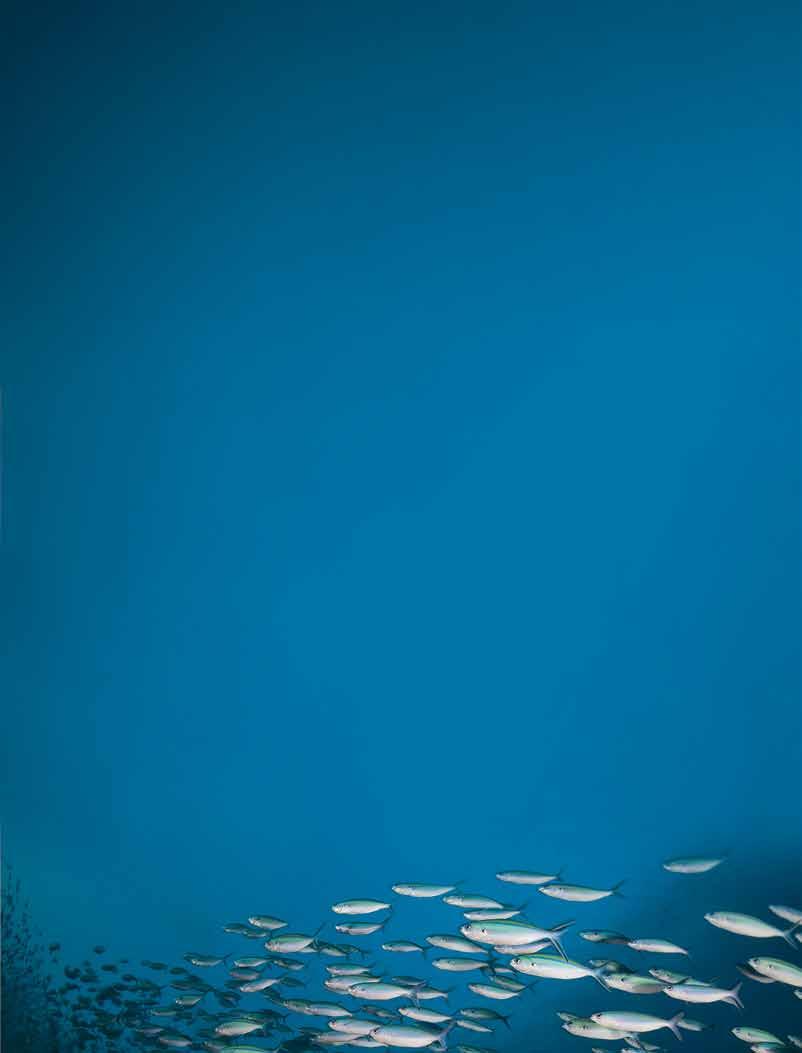
OCEANA.ORG | 13
Daniel Pauly is a Professor of Fisheries at the Fisheriesa Centre of the University of British Columbia, the Principal Investigator of the Sea Around Us Project, and a member of the Board of Oceana.
© Brant Shenkarow
Stars Come Out for Fifth Annual SeaChange Summer Party


On July 29th, approximately 400 guests gathered at Karen and Bruce Cahill’s stunning coastal villa in Laguna Beach for the 5th annual SeaChange Summer Party. The event was emceed by Oceana Senior Advisor Alexandra Cousteau and included insightful remarks delivered by Oceana Executive Vice President Jim Simon.




The speaking program also included remarks from such celebrated actors and ocean advocates as Ted Danson, Morgan Freeman, Dennis Haysbert, Aimee Teegarden and Sarah Shahi, in addition to live jazz performed by Jeff Goldblum and the Mildred Snitzer Orchestra and surprise guest vocalist Renee Olstead. Other special guests in attendance included Jenna Ushkowitz, Rachael Harris, Steve Howey, Ed Begley Jr., Beverly D’Angelo, Bella Thorne and Graham Phillips. The evening also included a special presentation to the first ever SeaChange Ocean Champions, Tricia and Michael Berns and South Coast Plaza, who were recognized for their loyal support throughout the history of the event.
This year’s anniversary event raised over $1 million for the oceans, thanks in large part to the dedication of co-chairs Eve Kornyei Ruffatto and Oceana board member Valarie Van Cleave, as well as the invaluable assistance of Oceana board member Keith Addis. Additionally, generous support was contributed by SeaChange’s underwriters and partners, which are listed at seachangesummerparty.org.
GQ Gentlemen’s Fund Ball
On Wednesday, October 24th over 250 guests gathered at the IAC building in New York City to celebrate the 5th Anniversary of the GQ Gentlemen’s Fund Ball, an event that honors extraordinary men who make a difference, and raises money for the charities they support. Oceana was there thanks to our friends at Nautica who, for the third year in a row, selected Oceana as their partner charity for the event. During the evening Oceana was represented by two exceptional gentlemen: Oceana board member Michael Northrop and fellow board member and newly-minted
14 | FALL/WINTER 2012 title eventS
Clockwise: Ted Danson, Oceana EVP Jim Simon, Oceana Senior Advisor Alexandra Cousteau, Ed Begley Jr., Rachael Harris, Dennis Haysbert; Sarah Shahi and SeaChange Ocean Champions Michael and Tricia Berns; Graham Phillips and Morgan Freeman; Jenna Ushkowitz; Oceana Senior Advisor Alexandra Cousteau, Co-Chair Eve Kornyei Ruffatto, Karen Cahill, Co-Chair and Oceana board member Valarie Van Cleave
© Bob Hodson
© Ann Chatillon
© Nicholas Koons
© Nicholas Koons © Bob Hodson
Gentlemen’s Fund Ambassador, Ted Danson. Oceana congratulates GQ for five successful years of the Gentlemen’s Fund and is deeply appreciative of our partners at Nautica for enabling our participation in this special event.
Clockwise: Ted Danson, Bob Sauerberg, Michael Strahan, Shaun White and Chris Mitchell
© Larry Busacca
Oceana and Christie’s Celebrate Yves Klein and La Revolution Bleue
On May 3rd, Oceana collaborated with international auction house Christie’s to produce a screening at the famed Paris Theatre in New York City. The evening, which also included an after party held at the glamorous Casa Lever restaurant, celebrated both Oceana and the life and legacy of the late French artist, Yves Klein, and was a prelude to the Post War and Contemporary evening sale on May 8th, which included Klein’s masterpiece FC1. The piece was sold for $32.5 million, and Oceana received $1 million from the anonymous seller.

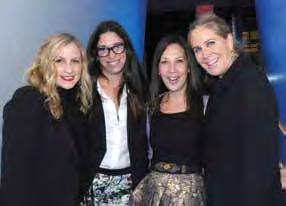
Oceana celebrity ambassador January Jones hosted the screening and after party, which was co-chaired by Stephen Murphy, Brett Gorvy and Loic Gouzer of Christie’s as well as Oceana board members Ted Danson and Susan Rockefeller along with her husband David. Generous support was also provided by the ocean advocates at La Mer.
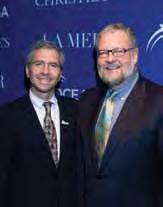


Oceana’s Board of Directors Gathers in Cardiff

In September, Oceana’s board of directors, executive committee and special guests gathered in Cardiff for the Oceana fall board meeting. The gathering was graciously hosted by Oceana board member and
Chair of the Waterloo Foundation, Heather Stevens. Following two days of discussion concerning Oceana’s campaign progress thus far and the strategy for 2013 and beyond, the group gathered for an
intimate party at the National Museum of Wales, where they enjoyed cocktails and conversation with special guest Hugh Fearnley-Whittingstall, celebrity chef, author, television personality and activist.
Left to right: Oceana CEO Andy Sharpless, Oceana board president Keith Addis, Hugh Fearnley-Whittingstall, Oceana board chair Kristian Parker and Oceana board vice chair Jim Sandler; Hugh Fearnley-Whittingstall, board member Sam Waterston, board member Heather Stevens, Andy Sharpless and board member Dr. Daniel Pauly.
OCEANA.ORG | 15 title
eventS
Clockwise: January Jones, Oceana board member Susan Rockefeller, Loic Gouzer, and Brett Gorvy of Christie’s; Georgina Bloomberg; Oceana EVP Jim Simon, David Rockefeller Jr.; Vanesa Dabich, Patricia Tortolani, Sandra Main and Veronika Ullmer of La Mer.
© John Dee
© Patrick McMcullan
© John Dee
© Patrick McMcullan
Make every day
earth day
oceana is a member of earthShare, a federation that represents the nation’s most respected environmental and conservation charities in hundreds of workplace giving campaigns across the country.
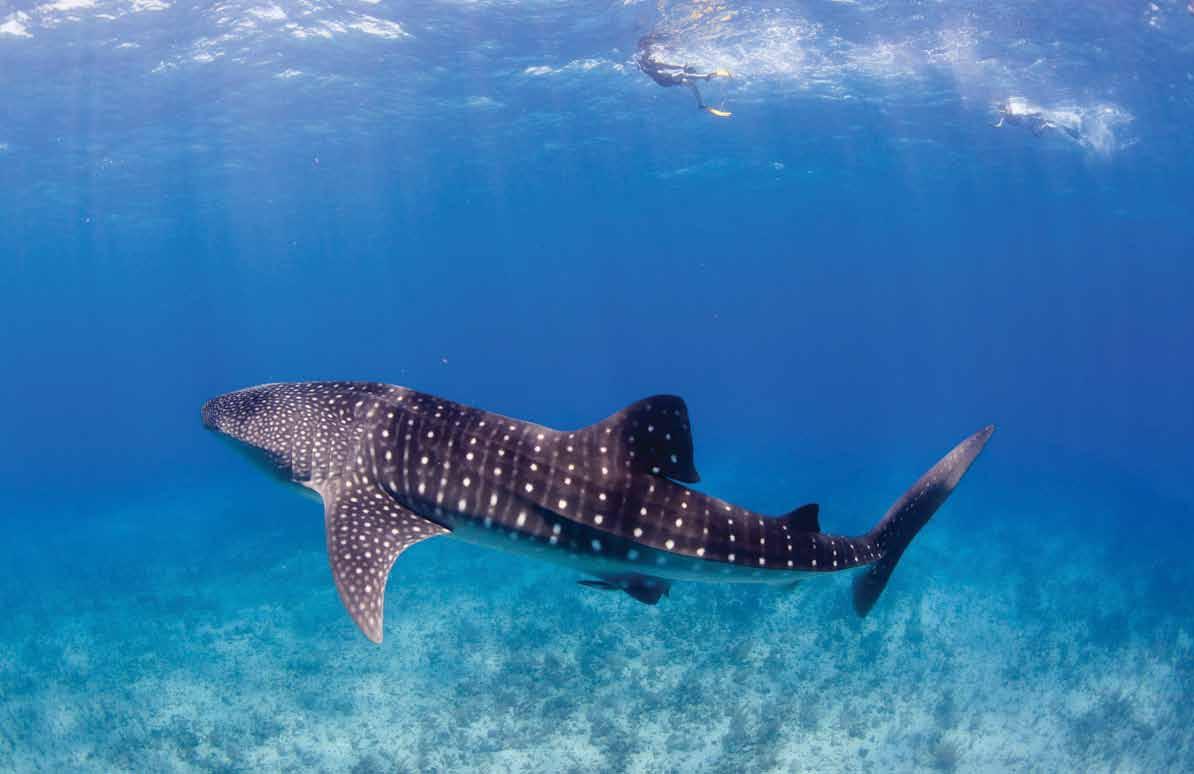
1% for the planet is a growing global movement of over 1,400 member companies – small and large – in 38 countries that donate at least 1% of sales to environmental organizations. as a 1% non-profit partner, oceana may accept donations from members of the 1% network – a network growing every day. over 2,100 non-profits worldwide are included in the 1% program, and over $50 million has been funneled toward nonprofit partners to date.

16 | FALL/WINTER 2012
EarthShare’s payroll contribution program allows donors to direct their contributions to Oceana; to any combination of EarthShare’s members; or to all of them through one general gift to EarthShare! To find out more about how you and your workplace can support Oceana through an EarthShare campaign, please email info@oceana.org or visit EarthShare’s website at earthshare.org.
tricia and michael berns
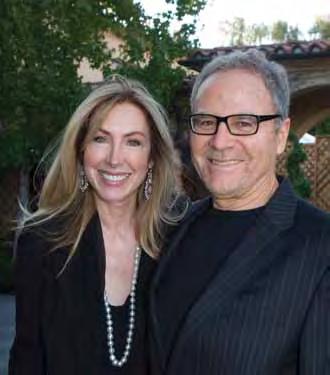
Twenty years ago, the couple went on a scuba diving excursion near the island of Rangiroa in Tahiti. During one dive they counted an astounding 132 gray reef sharks visible at one time, ranging from four to seven feet in length.

Just over a decade later, they returned to the same dive site and did exactly the same drift dive. This time they saw no more than 12 or 15 gray reef sharks in a single dive, and their sizes had shrunk to just 2 to 3 feet in length.
Later that same night they saw a commercial longline vessel – most likely one cause of the declining shark population.
“Since a great many of our vacations are actually live-aboard dive boat trips, we could tell you many other similar sad stories – listening to the sound of pristine reefs being dynamited, maneuvering our boat around drift nets, seeing abandoned fish traps filled with dead fish, and seeing shark fins hanging from the lines of fishing boats,” Michael Berns said.
So when they learned about Oceana’s first SeaChange benefit in Southern California
in 2008, they were ready to lend their support on the spot.
“We had to be the easiest people to recruit in the history of Oceana,” said Tricia Berns.
They have been underwriters of the event every year since, and at this year’s SeaChange, the Berns were honored as Ocean Champions.
“We were delighted and very honored to be named Ocean Champions,” Tricia said.
“We are very excited by the great progress being made by Oceana to protect the world’s oceans, and we want to be a part of it forever.”
Michael took up underwater photography nearly 30 years ago and has since logged more than a thousand dives around the world and has captured many more undersea photos of sea animals and habitat. Tricia learned to scuba dive more than 20 years ago and has been Michael’s constant guide and companion ever since. The couple particularly loves diving in the Galapagos Islands, where they explain, “it’s possible to dive with sea lions on the first dive, a large school of hammerhead sharks on the second, and have a 40-foot whale shark swim five feet away from you on the third.”
In addition to their passion for diving, the Berns have become dedicated advocates for protecting the world’s wild seafood.
“For us, the most important conservation issue is the safeguarding of the world’s fisheries,” Michael said. “We believe that the bounty of the ocean belongs not only to our generation but for all generations in the future.”
OCEANA.ORG | 17
Long before Tricia and Michael Berns got involved with Oceana, they were avid divers and ocean conservationists.
We believe that the bounty of the ocean belongs not only to our generation but for all generations in the future.
S U pp orter Spotli G ht
© Ann Chatillon
A remora attaches itself to Tricia Berns on a dive in Belize.
hugh fearnley-Whittingstall
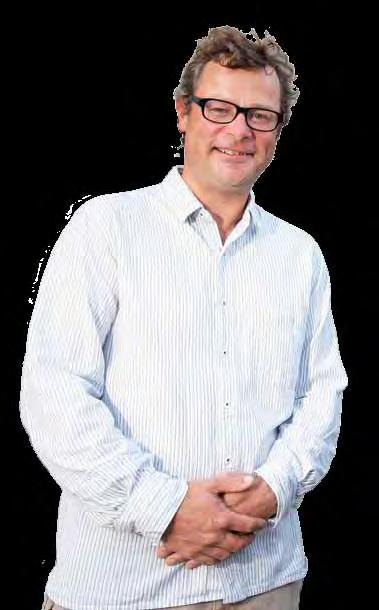
Hugh Fearnley-Whittingstall has become one of Britain’s most celebrated food personalities through his River Cottage TV series and books, which reflect his commitment to seasonal, sustainable food.
He is also a formidable advocate for sustainable fishing policy. In 2011, when Hugh learned that half the fish caught in the North Sea are thrown back into the sea, dead, he launched a campaign known as “Hugh’s Fish Fight” to educate the public about the massive problem of bycatch in the EU, and to effect policy change.
More than 700, 000 people have signed the fish fight petition, and the campaign
pressure led to a debate about discards in the Houses of Parliament. In July, as a result of pressure from Hugh and others, including Oceana, the European Commission published their proposals for a new Common Fisheries Policy, including recommendations for a discard ban.
“Fish are among the most precious of foods. Their numbers are not inexhaustible and we cannot afford to squander them idly,” said Fearnley-Whittingstall.
QU i ck-fried mackerel filletS With Garlic and bay
Cut the fillets from either side of the mackerel. Season them with a little salt and pepper.
Fresh mackerel, 1 per person Olive oil
A few garlic cloves, thickly sliced
A few bay leaves, coarsely torn ½ lemon
Salt and freshly ground black pepper
Put a large frying pan over medium heat and add a thin film of olive oil. When the oil is fairly hot, scatter in the garlic and bay leaves, then lay the mackerel fillets over them, skin side down. You’re looking for a gentle sizzle rather than a fierce flash-fry. As it cooks, the mackerel flesh will change from translucent pink to opaque white. When the fillets are almost completely white, turn them over
for just a minute to finish cooking. The whole process won’t take longer than 5 minutes. Let the garlic and bay just sizzle in the oil under and next to the fish, flavoring it gently.
Lift the mackerel fillets from the pan, leaving the bay and garlic behind (they’re probably just starting to burn a bit). Give the fillets a squeeze of lemon juice and serve right away, with salad (a sliced tomato salad is delicious with mackerel) and either new potatoes or buttered bread.
Reprinted with permission from The River Cottage Fish Book
18 | FALL/WINTER 2012 title chef’S corner
Actress and Oceana supporter
Kate Walsh traveled to Belize to spread the word about the threat of offshore drilling facing the Belize Barrier Reef, the world’s second largest barrier reef. Walsh visited some of Belize’s most well-known marine attractions, including the famous Blue Hole, a scuba diving mecca, which is threatened by potential drilling.

titlepartin G S h ot
© Tony Rath
Oceana’s accomplishments wouldn’t be possible without the support of its members.
Oceana is a 501(c)(3) organization as designated by the Internal Revenue Service.
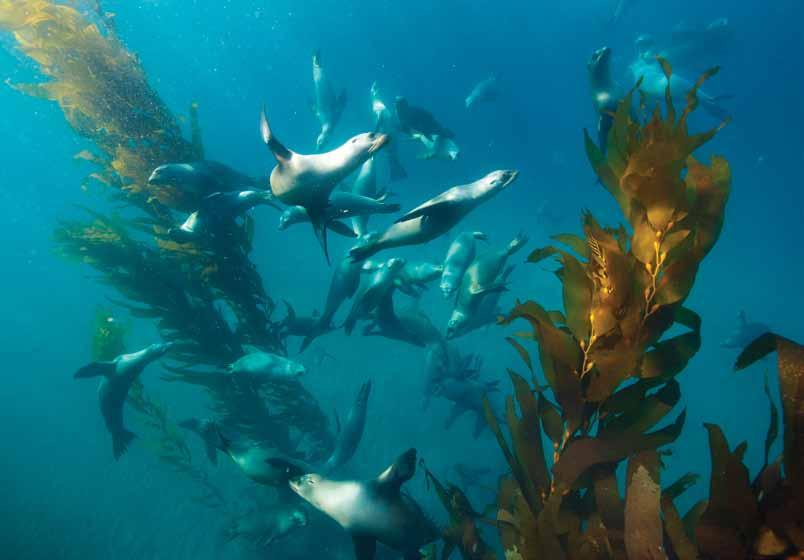
|
Global | Washington, DC europe | Brussels | Madrid
Copenhagen north america | Boston | Ft. Lauderdale | Juneau | Monterey | New York | Portland central america | Belize City South america | Santiago Give today at Oceana.org/give 1350 Connecticut Ave. NW, 5th Floor Washington, DC 20036 phone: +1.202.833.3900 toll-free: 1.877.7.OCEANA You can help Oceana fight to restore our oceans with your financial contribution. Call us today at 1.877.7.OCEANA, go to our website www.oceana.org/give and click on “give today” or use the envelope provided in this newsletter. You can also invest in the future of our oceans by remembering Oceana in your will. Please contact us to find out how. All contributions to Oceana are tax deductible.
Santa Barbara Island © Tim Calver






 Protecting the World’s Oc eans
Protecting the World’s Oc eans










 © Jim Agronick
© Jim Agronick


























